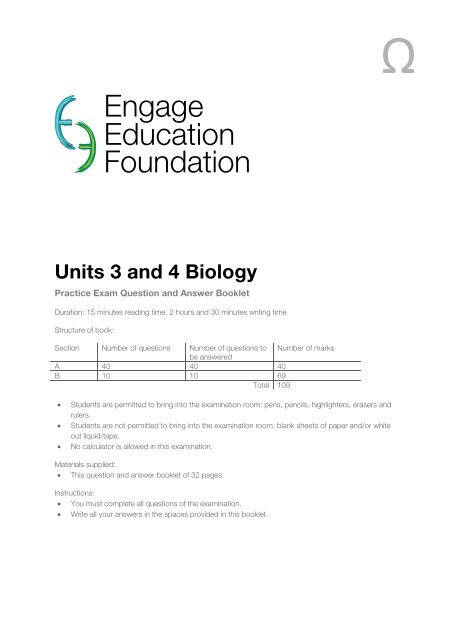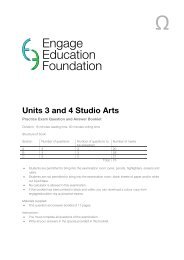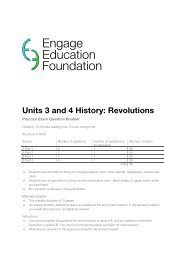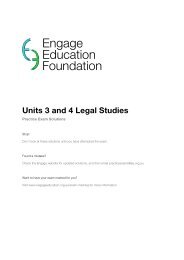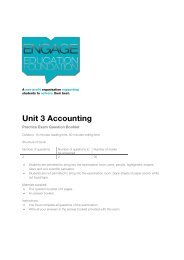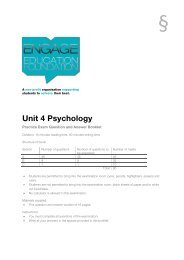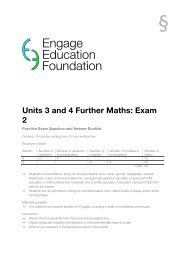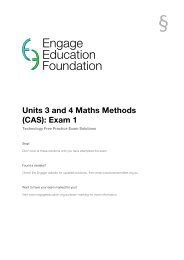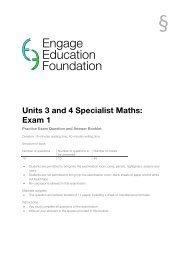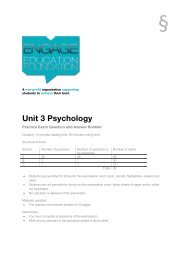Units 3 and 4 Biology - Practice Exam - Engage Education Foundation
Units 3 and 4 Biology - Practice Exam - Engage Education Foundation
Units 3 and 4 Biology - Practice Exam - Engage Education Foundation
- No tags were found...
You also want an ePaper? Increase the reach of your titles
YUMPU automatically turns print PDFs into web optimized ePapers that Google loves.
Ω<strong>Engage</strong><strong>Education</strong><strong>Foundation</strong><strong>Units</strong> 3 <strong>and</strong> 4 <strong>Biology</strong><strong>Practice</strong> <strong>Exam</strong> Question <strong>and</strong> Answer BookletDuration: 15 minutes reading time, 2 hours <strong>and</strong> 30 minutes writing timeStructure of book:Section Number of questions Number of questions to Number of marksbe answeredA 40 40 40B 10 10 69Total 109Students are permitted to bring into the examination room: pens, pencils, highlighters, erasers <strong>and</strong>rulers.Students are not permitted to bring into the examination room: blank sheets of paper <strong>and</strong>/or whiteout liquid/tape.No calculator is allowed in this examination.Materials supplied: This question <strong>and</strong> answer booklet of 32 pages.Instructions: You must complete all questions of the examination. Write all your answers in the spaces provided in this booklet.
<strong>Units</strong> 3 <strong>and</strong> 4 <strong>Biology</strong>The <strong>Engage</strong> <strong>Education</strong> <strong>Foundation</strong>Section A – Multiple-choice questionsInstructionsAnswer all questions by circling your choice.Choose the response that is correct or that best answers the question.A correct answer scores 1, an incorrect answer scores 0.Marks will not be deducted for incorrect answers.No marks will be given if more than one answer is completed for any question.QuestionsQuestion 1The following diagram depicts a plant cell.ACBDIt would be reasonable to conclude that the vacuole is:A. Structure AB. Structure BC. Structure CD. Structure DQuestion 2The final acceptor molecule in the electron transport chain is:A. Carbon dioxideB. NADH+C. FADH2D. OxygenPage 16.5 hour revision seminars for just $56 – visit www.ee.org.au for more info.
The <strong>Engage</strong> <strong>Education</strong> <strong>Foundation</strong><strong>Units</strong> 3 <strong>and</strong> 4 <strong>Biology</strong>Question 3Which of the following reaction models most accurately represents the action of an enzyme?Key: E: Enzyme, S1: Substrate 1, S2: Substrate 2, P1: Product 1, P2: Product 2A. E + S1 P1+P2B. E+P1+P2 S1+EC. S1+E E+P1+P2D. S1+S2 E+P1Question 4The section of a chloroplast in which the light independent phase of photosynthesis occurs is called the:A. GranumB. Thylakoid membraneC. StromaD. ChlorophyllQuestion 5An onion skin cell was left in distilled water for 24 hours. The cell would:A. Become turgidB. LyseC. CrenateD. PlasmoliseQuestion 6Fibrin is a:A. Secondary protein involved in the formation of muscleB. Tertiary protein involved in the synthesis of skin cellsC. Secondary protein involved in the clotting of bloodD. Steroid hormone involved in male reproductionQuestion 7What is an embolism in plants?A. A blockage of the phloem due to a build-up of sucrose, or low amounts of sucroseB. A rupture in the xylemC. A blockage in the xylem due to air bubbles, frozen water or low waterD. A rupture in the phloemQuestion 8Plants adapted to live in hot dry conditions are:A. XerophytesB. HalophytesC. AridophytesD. Hydrophyteswww.engageeducation.org.au Page 2
<strong>Units</strong> 3 <strong>and</strong> 4 <strong>Biology</strong>The <strong>Engage</strong> <strong>Education</strong> <strong>Foundation</strong>Question 9Chemical analysis of a section of DNA determined that its thymine quantity was 30%. What would be thepercentage of adenine in the mRNA coded for by this gene (assuming no splicing of introns or addition ofbases following transcription)?A. 20%B. 30%C. 40%D. 60%Page 36.5 hour revision seminars for just $56 – visit www.ee.org.au for more info.
The <strong>Engage</strong> <strong>Education</strong> <strong>Foundation</strong><strong>Units</strong> 3 <strong>and</strong> 4 <strong>Biology</strong>Questions 10, 11 <strong>and</strong> 12 refer to the following diagram:Source: Wikimedia CommonsQuestion 10The region across which neurotransmitters diffuse is marked:A. 6B. BC. 1D. CQuestion 11Structures 1 <strong>and</strong> 4, respectively, are produced in the:A. Golgi Apparatus, ribosomesB. Ribosomes, Golgi apparatusC. Endoplasmic reticulum, ribosomesD. Endoplasmic reticulum, Golgi apparatusQuestion 12Fill in the gaps: Enough of (A) must bind to (B) in order for (C) to be activated <strong>and</strong> for the message tocontinue electrically along the neuron.A. A: 2, B: 6, C: 4B. A: 4, B: 2, C: 4C. A: 4, B: 6, C: 5D. A: 4, B: 6, C: 2www.engageeducation.org.au Page 4
<strong>Units</strong> 3 <strong>and</strong> 4 <strong>Biology</strong>The <strong>Engage</strong> <strong>Education</strong> <strong>Foundation</strong>Question 13Following an infection that stimulates the body’s third line of defence, the specific immune system, amemory is kept of the event for future defence. Where is this information kept?A. In the plasma B lymphocytes in the bone marrowB. In the memory B lymphocytes in the plasma membraneC. In the memory B lymphocytes in the bone marrowD. In the plasma B lymphocytes in the plasma membraneQuestion 14The molecule responsible for allergic reactions is:A. HistidineB. HistonesC. HistamineD. HelicaseQuestion 15An example of active, natural immunity is:A. A mother passing antibodies in the colostrum of her breast milk to her newly born childB. A human receiving a tetanus vaccineC. A human being bitten by a snake <strong>and</strong> administered snake anti-venom taken from the serum of ahorseD. A human being exposed to chicken pox as a child <strong>and</strong> never becoming re-infectedPage 56.5 hour revision seminars for just $56 – visit www.ee.org.au for more info.
The <strong>Engage</strong> <strong>Education</strong> <strong>Foundation</strong><strong>Units</strong> 3 <strong>and</strong> 4 <strong>Biology</strong>Questions 16, 17 <strong>and</strong> 18 refer to the following diagrams:A B C DQuestion 16Which of the images depicts a peptide bond?A. AB. BC. CD. DQuestion 17Which of the images depicts a triglyceride?A. AB. BC. CD. DQuestion 18Which of the images depicts a monosaccharide?A. AB. BC. CD. DQuestion 19Histones are:A. Small negatively charged proteins that help keep enzymes togetherB. Small positively charged proteins that help keep DNA molecules wound up tightlyC. Small negatively charged proteins that help unwind DNA for transcriptionD. Small positively charged proteins that keep chromosomes separate from one anotherQuestion 20Hormones that diffuse externally to an organism <strong>and</strong> bind to specific external receptors, initiating aresponse are:A. A. PheromonesB. B. AuxinsC. C. EthyleneD. D. Steroidswww.engageeducation.org.au Page 6
<strong>Units</strong> 3 <strong>and</strong> 4 <strong>Biology</strong>The <strong>Engage</strong> <strong>Education</strong> <strong>Foundation</strong>Question 21Males have a greater chance of being affected by X-linked disorders because:A. They possess two copies of the chromosome containing the geneB. They possess one copy of the chromosome containing the geneC. A gene on the Y chromosome makes males more susceptible to diseaseD. Males possess less chromosomes than femalesQuestion 22There are approximately 10,000 pug dogs in Britain; however their gene pool only equates to that ofabout 50 individuals. This lack of genetic variation is due to:A. Natural selectionB. MutationC. The bottleneck effectD. Artificial selectionQuestion 23Natural selection acts upon an individual’s:A. GenotypeB. PhenotypeC. EnvironmentD. ChromosomesPage 76.5 hour revision seminars for just $56 – visit www.ee.org.au for more info.
The <strong>Engage</strong> <strong>Education</strong> <strong>Foundation</strong><strong>Units</strong> 3 <strong>and</strong> 4 <strong>Biology</strong>Question 24Source: Wikimedia CommonsBased on the image above, which of the following is not evidence of structural change that occurredduring Hominid evolution?A. Shorter <strong>and</strong> broader pelvisB. Flattening of the faceC. Enlargement of the frontal lobe proportional to the rest of the brain <strong>and</strong> an increase in the size ofthe cranial cavityD. Decreased prominence of brow ridgesQuestion 25The following table depicts the number of amino acid differences in a polypeptide found in a largenumber of primate species, <strong>and</strong> can be used to determine an estimate of evolutionary distances.It is thus reasonable to conclude that:Species compared Number of aminoacid differencesMan vs Chimpanzee 0Man vs Gorilla 4Man vs Monkey 11Monkey vs Chimpanzee 11Monkey vs Gorilla 15A. Humans <strong>and</strong> gorillas may differ in more than four bases in the DNA sequence which codes forthis proteinB. Gorillas are more closely related to chimpanzees than humans are to chimpanzees.C. Monkeys <strong>and</strong> gorillas share a more recent common ancestor than do humans <strong>and</strong> gorillasD. Humans <strong>and</strong> chimpanzees have identical DNA sequences in the gene which codes for thisprotein.www.engageeducation.org.au Page 8
<strong>Units</strong> 3 <strong>and</strong> 4 <strong>Biology</strong>The <strong>Engage</strong> <strong>Education</strong> <strong>Foundation</strong>Question 26Recombination occurs during:A. Prophase 1 of mitosisB. Prophase 1 of meiosisC. Prophase 2 of mitosisD. Prophase 2 of meiosisQuestion 27The recessive allele for Tay Sach’s disease is lethal when homozygous, meaning sufferers do not survivepast the age of approximately 5 years. Two parents who are both heterozygous at this gene locus had achild. The chance that their adult child is heterozygous is:A. 3/4B. 2/3C. 1/4D. 1/2Question 28<strong>Exam</strong>ples of sexual reproduction include:A. BuddingB. Vegetative reproductionC. MeiosisD. FragmentationPage 96.5 hour revision seminars for just $56 – visit www.ee.org.au for more info.
The <strong>Engage</strong> <strong>Education</strong> <strong>Foundation</strong><strong>Units</strong> 3 <strong>and</strong> 4 <strong>Biology</strong>Questions 29 to 32 refer to the following information:Horse coat colour is determined by the dominant allele B, which produces a brown colour, <strong>and</strong> therecessive b allele, which produces a tan colour. There is another gene coding for the presence ofpigment in the horse’s coat. The presence of the dominant allele for this gene, C, simply means that thehorse will have coat colour. If the horse is homozygous recessive at this locus (cc) there is nopigmentation <strong>and</strong> the horse will be white regardless of alleles coding for brown or tan colour. The B locus<strong>and</strong> the C locus are independently assorting.Two horses, heterozygous at both loci are crossed.Question 29What are the genotypes of the crossed horses?A. BBcc x bbCCB. bbCC x BbCcC. BbCc x BbCcD. bbcc x BBCCQuestion 30What possible gametes could occur in each horse as a result of meiosis?A. BC, Bc, bC, bcB. BC, bcC. bC, bc, cb, CbD. cB, CB, cb, CbQuestion 31What are the phenotypic ratios of the offspring?The punnet square template provided may be useful when determining your answer.A. 12 brown : 3 white : 1 tanB. 9 brown : 4 white : 3 tanC. 9 brown : 3 white : 3 tanD. 12 brown : 3 tan : 1 whitewww.engageeducation.org.au Page 10
<strong>Units</strong> 3 <strong>and</strong> 4 <strong>Biology</strong>The <strong>Engage</strong> <strong>Education</strong> <strong>Foundation</strong>Question 32The genetic phenomenon described, where the phenotype of one genotype can mask the phenotype ofanother genotype, is called:A. Dominant EpistasisB. Co-dominanceC. Incomplete dominanceD. Recessive EpistasisPage 116.5 hour revision seminars for just $56 – visit www.ee.org.au for more info.
The <strong>Engage</strong> <strong>Education</strong> <strong>Foundation</strong><strong>Units</strong> 3 <strong>and</strong> 4 <strong>Biology</strong>Questions 33 <strong>and</strong> 34 refer to the following pedigree:Source: Wikimedia Commons (Author: Jerome Walker)Question 33What mode of inheritance is shown for the trait being represented in the pedigree?A. Autosomal dominantB. Autosomal recessiveC. X linked dominantD. X linked recessiveQuestion 34If individual III1 were to mate with an individual that did not display the trait, what would be the probabilitythat their offspring WOULD display the trait?A. 1/3B. 1/4C. 1/2D. 1www.engageeducation.org.au Page 12
<strong>Units</strong> 3 <strong>and</strong> 4 <strong>Biology</strong>The <strong>Engage</strong> <strong>Education</strong> <strong>Foundation</strong>Question 35Which of the following is not an example of analogous features?A. Similar wing structure on a bird <strong>and</strong> a batB. Human <strong>and</strong> horse forelimbs having matching bone structure, with differences being simply dueto shape.C. The eye of a mosquito being similar in function to that of a birdD. The eye of an octopus having similar function <strong>and</strong> structure to that of a humanQuestion 36The half-life of carbon 14 is approximately 5730 years. If a sample of coal was dated to determine its age<strong>and</strong> was found to have 1/8 its original amount of carbon 14, how old would it be?A. 5730 x 16 yearsB. 5730 x 3 yearsC. 5730 x 4 yearsD. 5730 x 8 yearsQuestion 37The amount of DNA present in the nucleus at the end of the G2 phase of the cell cycle is:A. Half the amount that was present at the beginning of the G2 phaseB. Double the amount that was present at the beginning of the G2 phaseC. Half the amount that was present in the G1 phaseD. Double the amount that was present at the end of the G1 phasePage 136.5 hour revision seminars for just $56 – visit www.ee.org.au for more info.
The <strong>Engage</strong> <strong>Education</strong> <strong>Foundation</strong><strong>Units</strong> 3 <strong>and</strong> 4 <strong>Biology</strong>Question 38Source: Wikimedia Commons (Author: Nick Ares)The image above is of Atlantic giant pumpkins at a weigh-off in California. The genetic event that hascaused the pumpkins to grow so large is:A. Non-disjunctionB. PolyploidyC. DNA replicationD. Euploidywww.engageeducation.org.au Page 14
<strong>Units</strong> 3 <strong>and</strong> 4 <strong>Biology</strong>The <strong>Engage</strong> <strong>Education</strong> <strong>Foundation</strong>Question 39Source: Wikimedia CommonsThe karyotype shown above is of that of a child suffering from Down’s syndrome. The genetic event thathas caused this is:A. Non disjunctionB. TranslocationC. Crossing overD. PolyploidyPage 156.5 hour revision seminars for just $56 – visit www.ee.org.au for more info.
The <strong>Engage</strong> <strong>Education</strong> <strong>Foundation</strong><strong>Units</strong> 3 <strong>and</strong> 4 <strong>Biology</strong>Question 40The process of inducing a bacterial cell to take up a recombinant plasmid is called:A. TransductionB. TransformationC. TranslocationD. Heat Shockwww.engageeducation.org.au Page 16
<strong>Units</strong> 3 <strong>and</strong> 4 <strong>Biology</strong>The <strong>Engage</strong> <strong>Education</strong> <strong>Foundation</strong>Section B – Short-answer questionsInstructionsAnswer all questions in the spaces provided.Unless otherwise indicated, the diagrams in this book are not drawn to scale.QuestionsQuestion 1a. Where in the cell does glycolysis occur?1 markb. Briefly summarise the inputs <strong>and</strong> outputs of glycolysis.Inputs:Outputs:2 marksPage 176.5 hour revision seminars for just $56 – visit www.ee.org.au for more info.
The <strong>Engage</strong> <strong>Education</strong> <strong>Foundation</strong><strong>Units</strong> 3 <strong>and</strong> 4 <strong>Biology</strong>Spinorolicus Cinzia is the first eukaryotic organism to be discovered that does not require oxygen at anystage of its life. This makes it an obligate anaerobe. Spinorolicus Cinzia was discovered in the anoxic(depleted of oxygen) L’Atlante Basin of the Mediterranean Sea.Spinorolicus Cinzia (Source: BBC)c. Why is it possible for Spinorolicus Cinzia to survive anaerobically but it is not possible for humansto?2 marksTotal: 5 markswww.engageeducation.org.au Page 18
<strong>Units</strong> 3 <strong>and</strong> 4 <strong>Biology</strong>The <strong>Engage</strong> <strong>Education</strong> <strong>Foundation</strong>Question 2a. Explain why a yellow banana, when placed in a paper lunch bag with an overripe orange, willbecome brown within a day.2 marksb. Briefly complete the following table:Plant tropism orPositive / negative /hormonenot applicableresponsePhototropism ofplant tip towardssunlightHormone(s)responsibleBrief function of this /these hormonesGeotropism upout of the groundGrowth of lateralbudsFlowering4 marksTotal: 6 marksPage 196.5 hour revision seminars for just $56 – visit www.ee.org.au for more info.
The <strong>Engage</strong> <strong>Education</strong> <strong>Foundation</strong><strong>Units</strong> 3 <strong>and</strong> 4 <strong>Biology</strong>Question 3The fight-or-flight response is a natural bodily response to potentially dangerous situations where stresshormones (adrenaline, for example) are released from the adrenal gl<strong>and</strong>s to prepare an animal for aresponse to danger. The response is characterised by actions such as shaking, tunnel vision,acceleration of heart/lung activity, increase in blood sugar levels <strong>and</strong> pupil dilation.a. Explain whether this is a nervous response, a hormonal response or both.2 marksThe production of the hormone adrenaline is a biological pathway characterised by a series of enzymecatalysedbiological reactions. The final step in this pathway begins with a hormone called noradrenaline,which not only works in a similar way to adrenaline, but is also converted to adrenaline by an enzyme inthe adrenal gl<strong>and</strong>. Suppose a person is producing too much adrenaline, <strong>and</strong> is suffering adverse effectssuch as increased blood pressure, constantly raised metabolic rate, <strong>and</strong> feelings of anxiousness.b. Outline a potential drug that could be synthesised to overcome this.3 marksTotal: 5 markswww.engageeducation.org.au Page 20
<strong>Units</strong> 3 <strong>and</strong> 4 <strong>Biology</strong>The <strong>Engage</strong> <strong>Education</strong> <strong>Foundation</strong>Question 4a. Explain why, in cases of fever, human body temperature will be raised to around 40 degreesCelsius, but if it is raised much higher there is a real cause for concern. If possible, include a graphin your answer.2 marksb. A person is bitten by a dog. Initially, blood flow to the wound appears unrestricted, but after aperiod of minutes it is obvious that the flow of blood is slowing. What process is responsible for thisobservation? Briefly outline this process.2 marksTotal: 4 marksPage 216.5 hour revision seminars for just $56 – visit www.ee.org.au for more info.
The <strong>Engage</strong> <strong>Education</strong> <strong>Foundation</strong><strong>Units</strong> 3 <strong>and</strong> 4 <strong>Biology</strong>Question 5An experiment was set up to analyse the effects of the plant hormone auxin. 3 shoots were grown inidentical conditions with one plant left intact, one with its coleoptile removed <strong>and</strong> then replaced <strong>and</strong> onewith its coleoptile tip removed <strong>and</strong> not replaced. All were subjected to equal light, H2O, CO2 <strong>and</strong>nutrients. The following diagram represents the experimental set up.a. Name the independent <strong>and</strong> dependent variables.b. What is the purpose of the shoot left intact?1 markc. Draw the expected results of the experiment.1 mark1 markwww.engageeducation.org.au Page 22
<strong>Units</strong> 3 <strong>and</strong> 4 <strong>Biology</strong>The <strong>Engage</strong> <strong>Education</strong> <strong>Foundation</strong>d. In the second part of the experiment, two more plant shoots were added with their tips cut off, onewith an agar block soaked in juices from ground up coleoptiles tips (plant 1) <strong>and</strong> one with a plainagar block on it (plant 2). The diagram below represents the experimental set up of these two newplants. Draw the expected results in the spaces on the right, <strong>and</strong> briefly explain the results for plant1.1 2 Results2 markse. What steps must be taken in experimental set ups such as this one to achieve conclusive results?2 marksTotal 7 marksPage 236.5 hour revision seminars for just $56 – visit www.ee.org.au for more info.
The <strong>Engage</strong> <strong>Education</strong> <strong>Foundation</strong><strong>Units</strong> 3 <strong>and</strong> 4 <strong>Biology</strong>Question 6a. Outline the function of the phospholipid bilayer of a cell membrane through the use of a labelleddiagram, showing all major structures <strong>and</strong> macromolecules.3 marksb. An experiment was set up as shown below with 1 cm x 1 cm x 1 cm potato cubes. Theconcentration of sucrose in each of the potato cubes is 0.1 M. A potato cube was placed in abeaker containing 50 mL distilled water, another potato cube was placed in a beaker containing 50mL 0.1 M sucrose solution <strong>and</strong> a third potato cube was placed in a beaker containing 50 mL 1.0 Msucrose solution, as shown below:distilled water 0.1 M sucrose 1.0 M sucroseFill in the following table with expected experimental results:BeakerPotato cubeappearanceType of solution (isotonic /hypertonic / hypotonic) thatthe potato was placed inBiological term describingthe cells of the potatocube after exposure tothe solution1233 markswww.engageeducation.org.au Page 24
<strong>Units</strong> 3 <strong>and</strong> 4 <strong>Biology</strong>The <strong>Engage</strong> <strong>Education</strong> <strong>Foundation</strong>c. Explain how altering the pH of a solution can alter the function of a plasma membrane.2 marksTotal 8 marksPage 256.5 hour revision seminars for just $56 – visit www.ee.org.au for more info.
The <strong>Engage</strong> <strong>Education</strong> <strong>Foundation</strong><strong>Units</strong> 3 <strong>and</strong> 4 <strong>Biology</strong>Question 7The diagram below is of the pork tapeworm, Taenia Solium, which is a eukaryotic parasite that lives inthe digestive tract of pigs.Source: Wikimedia Commonsa. What are two benefits of living the in digestive tract of the pig for Taenia Solium?Benefit 1:Benefit 2:2 marksb. What is one physical feature of the pork tapeworm that enables it to live in the intestines of a pig?How does it help the tapeworm survive?2 markswww.engageeducation.org.au Page 26
<strong>Units</strong> 3 <strong>and</strong> 4 <strong>Biology</strong>The <strong>Engage</strong> <strong>Education</strong> <strong>Foundation</strong>c. Explain, using Darwin’s theory of natural selection, how the feature you described in part b. couldhave evolved in Taenia Solium.3 marksTotal: 7 marksPage 276.5 hour revision seminars for just $56 – visit www.ee.org.au for more info.
The <strong>Engage</strong> <strong>Education</strong> <strong>Foundation</strong><strong>Units</strong> 3 <strong>and</strong> 4 <strong>Biology</strong>Question 8<strong>Exam</strong>ine the following graph depicting a population bottleneck.Source: Wikimedia Commons (Author: TedE)a. Give one human-caused <strong>and</strong> one nature-caused example of possible events that may cause apopulation bottleneck to occur.Human-caused:Nature-caused:2 markswww.engageeducation.org.au Page 28
<strong>Units</strong> 3 <strong>and</strong> 4 <strong>Biology</strong>The <strong>Engage</strong> <strong>Education</strong> <strong>Foundation</strong>b. What happens to the gene pool of a population following a bottleneck effect? Why?c. How does a bottleneck effect render a population more susceptible to future decline in numbers<strong>and</strong> gene pool?2 marks1 markTotal: 5 marksPage 296.5 hour revision seminars for just $56 – visit www.ee.org.au for more info.
The <strong>Engage</strong> <strong>Education</strong> <strong>Foundation</strong><strong>Units</strong> 3 <strong>and</strong> 4 <strong>Biology</strong>Question 9a. Re-write the following DNA sequence, adding in a frameshift mutation by mutation at, or adjacentto, the seventh base:3’ ATTCGATTGCCCATCTCGAAG 5’b. Explain, briefly, the events that occur during transcription.1 mark3 marksc. If a frameshift mutation has occurred, what consequence does this have on the polypeptide that thegene was coding for?d. What is meant by the statement ‘the genetic code is degenerate’?2 marks1 markTotal: 7 markswww.engageeducation.org.au Page 30
<strong>Units</strong> 3 <strong>and</strong> 4 <strong>Biology</strong>The <strong>Engage</strong> <strong>Education</strong> <strong>Foundation</strong>Question 10A mouse breeder made the following cross:Homozygous non-spotted female X homozygous spotted male.All of the offspring in the F1 were non-spotted.a. Which phenotype is dominant?1 markb. The genotype of the male parent was ss. What is the genotype of the offspring (the F1 generation)?c. What gametes will the F1 mice produce?1 markd. Two F1 individuals were crossed together <strong>and</strong> produced progeny. Fill in the appropriate details inthe following table:1 marke. What proportion of the offspring will be spotted?1 mark1 markf. What proportion of the offspring will be homozygotes?g. The mouse breeder decides to buy a mouse with no spots. How will he determine its genotype?1 mark1 markPage 316.5 hour revision seminars for just $56 – visit www.ee.org.au for more info.
The <strong>Engage</strong> <strong>Education</strong> <strong>Foundation</strong><strong>Units</strong> 3 <strong>and</strong> 4 <strong>Biology</strong>The colour of these spots in the mice is variable. That is, there are black spotted, brown spotted <strong>and</strong>mice with black <strong>and</strong> brown spots. The breeder crossed two different strains of non-spotted micetogether <strong>and</strong> obtained large numbers of offspring in the ratio below:1 black spotted : 2 black <strong>and</strong> brown spotted : 1 brown spotted : 12 non-spottedh. Using appropriate genetic terminology, explain these results. A punnet square may be useful.i. Assign every possible genotype to each of the following phenotypes:2 marksPhenotypeGenotypeNon-spottedBrown-spottedBrown <strong>and</strong>Black-spottedBlack-spotted6 marksTotal: 15 marksEnd of BookletLooking for solutions? Visit www.engageeducation.org.au/practice-examswww.engageeducation.org.au Page 32


